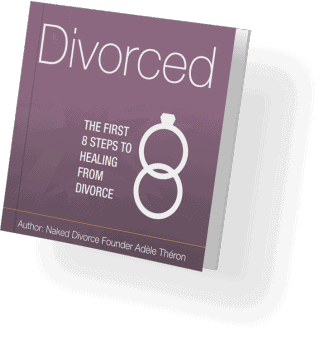
Free e-book: The First 8 Steps to healing from divorce
How To Handle Divorce Threats: NVC Strategies for Healthy Communication

Are you overwhelmed by fear and uncertainty due to your husband’s persistent divorce threats? Handling divorce threats effectively involves understanding their diverse forms, recognizing their profound impact on your emotional well-being, and embracing the empowering potential of Non-Violent Communication (NVC). In our exploration of how to handle divorce threats, we will delve into the various shapes these ultimatums can take, delve into the emotional turmoil they create, and illustrate how NVC can serve as a transformative tool for fostering healthier communication and lasting bonds.
What Are the Forms of Constant Divorce Threats?
Threats of perpetual divorce can take many different forms, and each has its own emotional significance. These threats can range from overt pronouncements of purpose to more subdued suggestions. Examples of such utterances could be, “I want a divorce,” or “I can’t do this anymore.” Additionally, they may be hiding behind frequent acts of silence, passive-aggressive comments, or a consistent lack of interest in the relationship. Acknowledging these various forms is essential because it enables you to approach the problem with a more profound comprehension of the dynamics involved.
The Impact of Constant Divorce Threats
Your emotional well-being suffers when divorce ultimatums are always hanging over you. Anxiety, dread, or avoidance behaviours might arise from attachment traumas triggered by the threat of impending separation. Your own neurotic tendencies may be triggered by your partner’s threats, in which case acting erratic or withdrawing could make things worse. Chronic stress brought on by a continuous state of uncertainty can negatively impact both the quality of your relationship and your general well-being. The first step in effectively tackling these risks is comprehending their emotional and psychological effects.
What Is Non-Violent Communication (NVC)?
In order to actively address these challenges, you might want to follow the principles of Non-Violent Communication (NVC). NVC, which was created by Rosenberg, places more emphasis on expressing your needs and feelings than it does on critiquing your partner’s actions. You establish a more secure environment for candid communication by expressing your needs and feelings. By using a formula that entails defining particular behaviours, expressing emotions, presenting wants and desires, and encouraging cooperation for a solution, NVC provides an organised way to communicating. It’s an effective tool that can guide you through the storm of potential divorce and help you create a strong, mutually beneficial partnership.
Using NVC in Practice
The practical application of Non-Violent Communication (NVC) to handle persistent divorce threats will be thoroughly discussed in the ensuing sections. This includes everything from establishing a positive dialogue environment to acknowledging one another’s viewpoints and, most importantly, establishing a secure environment where both parties can express their needs and feelings without inciting defensiveness. Together, let’s go out on this path to happier, healthier relationships.
Setting the Stage
One of the most important first towards correcting the situation is to have a discussion with your spouse about the ongoing threats of divorce. First, locate a peaceful, comfortable area where you may have uninterrupted conversations. After you’ve both settled in, politely ask to speak for a little while. This small gesture shows how much you value open communication and how committed you are to the partnership. By demonstrating that you’re interested in working together to find a solution rather than placing blame or making accusations, it establishes a respectful and considerate tone.
Express Your Emotions
It’s critical to express your emotions clearly when talking about a recent threat. Avoid placing blame and making accusations, as this may cause your partner to get defensive. Use “I” sentences to convey your feelings instead. Say something like, “I felt hurt and abandoned when you mentioned the possibility of divorce.” When you use “I” statements, you are taking responsibility for your sentiments and allowing your partner to sympathise with you instead of feeling attacked. Recall that the objective is to foster an atmosphere in which you both feel free to freely communicate your thoughts and feelings without worrying about criticism or rejection, in addition to just expressing your emotions. By taking this technique, you invite your partner to comprehend your emotional experience and create the foundation for a more compassionate and fruitful dialogue.
Stating Your Needs
In order to resolve conflicts resulting from ongoing threats of divorce, it is essential that you communicate your requirements clearly. As you proceed, concentrate on expressing your wants without passing judgement. Be clear about the things you want out of the relationship. A possible response could be something like this: “In our relationship, I need to feel a sense of partnership, certainty about our future, and understanding from you.” You can make your expectations clear to your partner by expressing your demands in this way. This stage aids in their comprehension of the essential components required for your emotional health in the partnership. Recall that your needs are legitimate, and being honest about them is a great approach to lay the groundwork for a stronger bond.
Inviting Collaboration
Creating a cooperative environment is crucial to finding a positive way to handle ongoing divorce threats. Send out an invitation to collaborate on discovering answers in order to do this. Make specific recommendations for steps to take, such as attending joint programmes designed to overcome obstacles as a team or seeking counselling or therapy. Your willingness to actively participate in overcoming hurdles and offering solutions are signs of your dedication to the relationship’s development. By taking this action, you can help your partner view you as a collaborator rather than an opponent while resolving conflicts. It develops a cooperative spirit that can be vital in resolving issues and forging a closer bond between the partners by establishing a shared sense of accountability for the health of the relationship. Putting a strong emphasis on cooperation guarantees that you and your spouse work together to achieve the same objective, which is a stronger, more stable relationship.
Validating Their Perspective
It’s important to ask your partner to share their views and feelings after you’ve shared your demands and emotions. Establish a space where people may open up without fear of criticism. Invite them to discuss their viewpoint on the matter in an honest manner. At this point, active listening is crucial. As they speak, pay more attention to comprehending their viewpoint than you are planning your reply. After that, give a brief summary of their issues to show that you comprehend and are prepared to listen. “I hear you’re feeling frustrated and uncertain about our relationship,” I may reply. Thank you for sharing that with me. By acknowledging their viewpoint, you are demonstrating that you respect their emotions and are receptive to learning more about it. It increases empathy and prepares the groundwork for a courteous, well-balanced discussion in which the opinions of both parties are taken into account.
The NVC Formula: When You, I Feel, I Need, Can We
The NVC formula “When You, I Feel, I Need, Can We” offers a methodical framework to efficiently direct your conversation:
- When You Start by objectively describing their particular actions or comments. Taking the example “When you mention divorce threats…”
- I Feel: Feelings should be communicated in reaction to their actions. “I” statements, such as “I feel anxious and hurt…” are useful for communicating your emotions.
- I Need: Clearly express what you need and want. Indicate what you require from the partnership, for example, “I need to feel more secure.”
- Can We: Send out an invitation to collaborate on finding a solution. “Can we explore ways to improve our communication?” is an example of a question you may ask to see if you can work together to find a solution. This methodical approach lessens the possibility of misunderstandings or defensiveness by keeping the discussion on topic and constructive. It guarantees that both parties are aware of each other’s requirements, wants, and intentions, which promotes more efficient problem-solving.
Creating Space for Understanding
Through the use of non-violent communication (NVC), partners can communicate their needs and feelings in a safe environment without having to resort to defensiveness. Defensiveness fades when you actively listen to each other and validate each other’s viewpoints, creating space for cooperative problem-solving. Deeper empathy and understanding are made possible in this safe setting, leading to more compassionate and fruitful dialogue. It serves as the cornerstone for cooperating to build the relationship and handling problems in a positive manner. Recall that the objective is to foster a deeper bond based on respect and understanding as well as conflict resolution. You may turn difficult times into chances for your relationship to improve and strengthen by accepting NVC.
Conclusion
Constant threats of divorce have the power to shatter bonds and exacerbate mental anguish. You may turn these difficult times into chances for growth and connection by using non-violent communication approaches. Recall that the secret to surviving adversity and creating a strong partnership is to promote understanding and attend to each other’s needs and feelings.
Call to Action (CTA)
Struggling with constant threats of divorce and unsure about your relationship’s future? We provide practical tips and techniques in our Spark Program to help repair damaged relationships. Make an appointment for a Clarity Call right now to start your journey to happier, healthier relationships. This is where your journey to comprehension and development begins.
At Naked Divorce, we have Recovery Programs and Retreats that have been created around helping you navigate the divorce grief life cycle in a healthy way.
Get in touch with Naked Divorce if you need support on your divorce journey.
If you enjoyed this post, I’d be very grateful if you’d help it spread by emailing it to a friend, or sharing it on Twitter or Facebook.
With you in service,


For a more personalized approach to your healing journey, book a free Clarity Call now. Our coaches are here to help you take your first steps towards healing. Check out our Resources or our Videos on YouTube.

